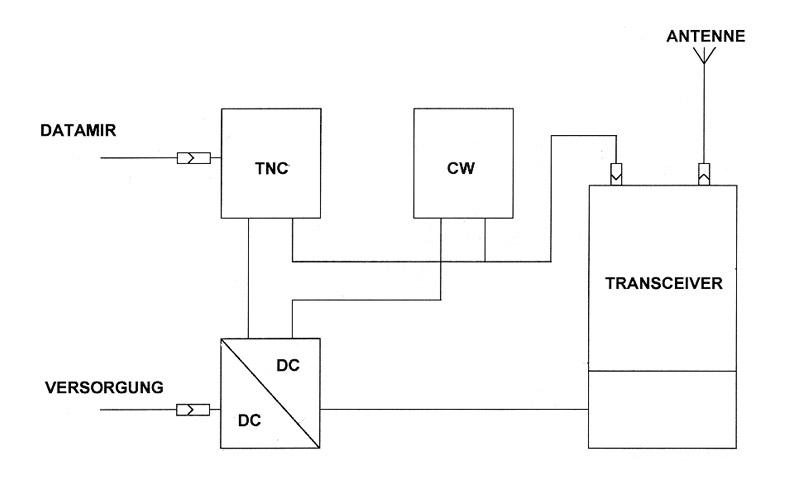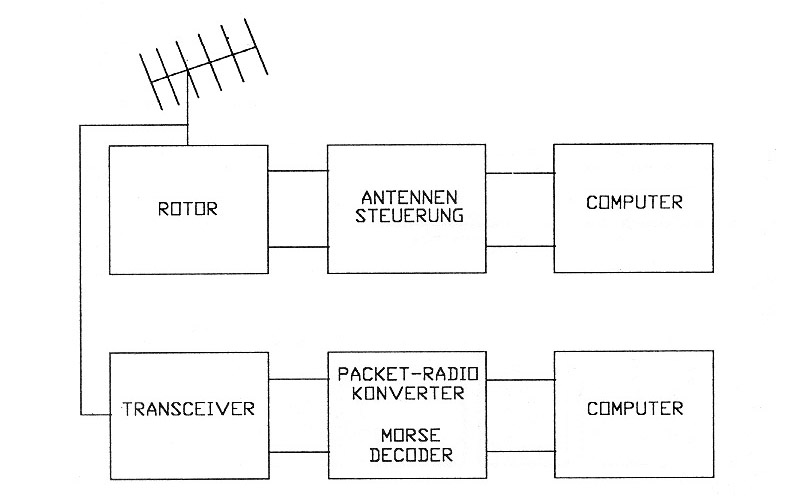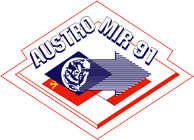In line with the AUSTROMIR 91 was among the scientific aspect an unifying component integrated, especially for the youth in the schools which could participate activ. A radio set was used in the line with the amateur radio experiment AREMIR as well as for the art experiment ARTSAT and enabled the amateur radio contacts with the space station MIR in frequency modulated voice radio-, packet-radio- and CW-operate.
Objectives
The Austrian Cosmonaut should have taken radio contact during his spare time with the help of the equipment AREMIR in the amateur radio band with interested schools and radio amateurs worldwide. For those overflights, at which the Cosmonaut was engaged with scientific tasks, was an automatic radio beacon in the apparture installed that it could also be tracked from earth. During a prject week in the schools practical experiments and eventbased school lessons were prepared during the education.
Another task of the project AREMIR came up from the co-operation at the art project ARTSAT.
Functionality
To emphasize the unifying component of the amateur radio, 100 special constructed reception kits from the OEVSV for the reception of the signals from the space station MIR and two complete packet-radio stations were consigned to Soviet radio amateurs and schools. For the paricipation of schools 150 pieces of these reception kits were compiled by the HTL (High Technical School) and the BVA (federal experimental institute) Wiener Neustadt, Department for electronic, in line of the practical training in the training workshops. Those were relayed to interested schools in Austria and the Soviet Union.
The equipment of the flying model AREMIR comprised three significant technologies for the amateur radio: As there was the 200. birthday of Samuel Morse in the year 1991, were emissions in Morse as the oldest packet-radio error-free digital data transmission and in one of the most state-of-the-art modulation forms used; and there also was the possibility of the regular voice radio.
Results
The equipment AREMIR was put into operation for the first time on the 6 October 1991 on board of the space station. The cosmonaut responded so the symbolic gesture of an artist from Graz, who “shook his hand” electronical. The radio signals he sent to earth gave the start impulse for the art project ARTSAT.
For the first time the message of the packet-radio beacon was heared:
AUSTROSOVJET RADIO TIME SPACE ART TELECREATION WELTRAUM KULTURRAUM RCCW TU GRAZ 1991 AREMIR.
During the proximate earth orbits the signals were clearly and strong receiveable.They could be trouble-free decoded by the earth station.
On the following day the radio signals out of space during the each 6 minutes lasting five earth orbits were heared in the information center of the Technical University of Graz, and seen in clear text on the monitors. In the broader course of the AUSTROMIR-mission all operating methods of radio contacts came into operation, as by the numerous acknowledgements of receipt from radio amateurs at home and abroad as well as by Austrian and Russian schools acknowledged. Except for some initial troubles with the signal transmission in the CW-Mode the equipment AREMIR as well as the on earth appointed receiver worked faultless.
For transportation and storaging of the equipment AREMIR in the space station scholars of the Moedlinger fashion school had made a bag from space capable textiles (the “space suit” of AREMIR).
Technical characteristics
The project AREMIR consisted of the following units


Amateur radio equipment for the space station
The equipment in the space station consisted of an automatic Morse text encoder, a Terminal Node Controller (TNC) and a Transceiver. Both flight versions of the equipment were designed after the strict requirements of the Soviet space technics and designed for the use in the space station. A standard transceiver had to be modified for this use equivalent. The equipment was released after the end of the scientific experiments on the space station and for the further use by amateur radio operator-cosmonauts, and was equipped with a specific interface for the connection with the central computer DATAMIR.
Integrated circuitries were inserted in the school receiver of the earth equipment. A few periphere parts, ceramics filters, and quartz made the installation and calibration easier, so that even less trained “amateurs” could make a successful assembly. One by the Soviet side desired calibration possibility on a fixed frequency was made possible as the integration into an of printed boards parts manufactured box and a in Russian labeled front cover.
For the receipt of the radio signals amateur radio operators of the RCCW built a fixed and a mobile earth station. Each construction consisted of an automatic tracking antenna, a transceiver, a packet-radio-converter and a Morse-decoder. The earth station was supported by two computers.
- Equipment AREMIR
- Radio unit ALINKO DJ 120 E modified
- Cable ARE1 (power supply)
- Antennae adaptor (2 pieces)
- Reserve fuses (3 pieces)
- Transport-drapery envelope
| Mass: | 2.0 kg |
| Dimensions: | 200 mm x 250 mm x 62 mm |
| Power input: | 27 W |
Experimenters
Gustav Paier
Austrian Experiment Sender Association, Sollenau
Technics:
o. Univ.-Prof. Dipl.-Ing. DDr. Willibald Riedler (institute manager)
Dipl.-Ing. Nicolas Valavanoglou (project manager)
Peter Nesswald
Ulrich Braendle
Andreas Merdonik
Siegfried Stoellner
all: Institute for Communications Engineering and Wave Propagation, Technical University Graz
